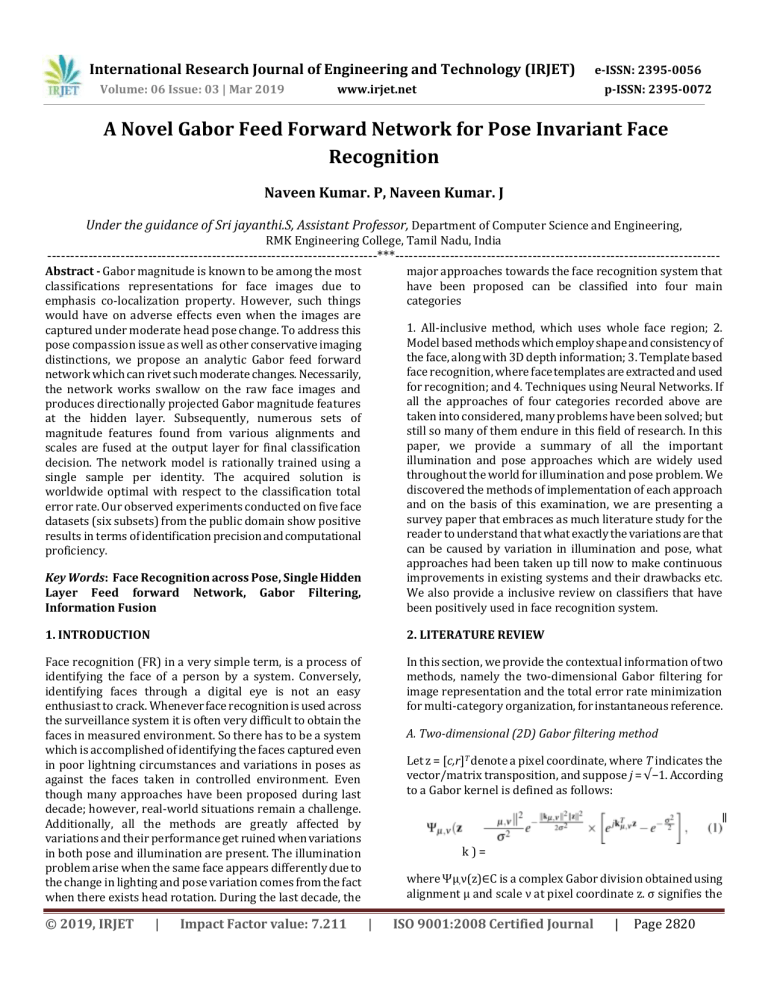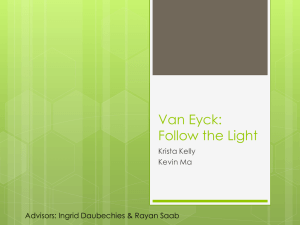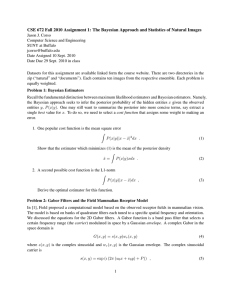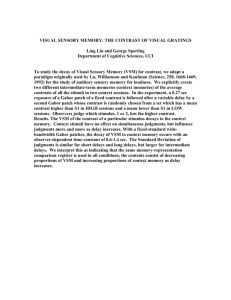IRJET- A Novel Gabor Feed Forward Network for Pose Invariant Face Recognition
advertisement

International Research Journal of Engineering and Technology (IRJET) Volume: 06 Issue: 03 | Mar 2019 www.irjet.net e-ISSN: 2395-0056 p-ISSN: 2395-0072 A Novel Gabor Feed Forward Network for Pose Invariant Face Recognition Naveen Kumar. P, Naveen Kumar. J Under the guidance of Sri jayanthi.S, Assistant Professor, Department of Computer Science and Engineering, RMK Engineering College, Tamil Nadu, India ------------------------------------------------------------------------***----------------------------------------------------------------------Abstract - Gabor magnitude is known to be among the most classifications representations for face images due to emphasis co-localization property. However, such things would have on adverse effects even when the images are captured under moderate head pose change. To address this pose compassion issue as well as other conservative imaging distinctions, we propose an analytic Gabor feed forward network which can rivet such moderate changes. Necessarily, the network works swallow on the raw face images and produces directionally projected Gabor magnitude features at the hidden layer. Subsequently, numerous sets of magnitude features found from various alignments and scales are fused at the output layer for final classification decision. The network model is rationally trained using a single sample per identity. The acquired solution is worldwide optimal with respect to the classification total error rate. Our observed experiments conducted on five face datasets (six subsets) from the public domain show positive results in terms of identification precision and computational proficiency. major approaches towards the face recognition system that have been proposed can be classified into four main categories Key Words: Face Recognition across Pose, Single Hidden Layer Feed forward Network, Gabor Filtering, Information Fusion 1. All-inclusive method, which uses whole face region; 2. Model based methods which employ shape and consistency of the face, along with 3D depth information; 3. Template based face recognition, where face templates are extracted and used for recognition; and 4. Techniques using Neural Networks. If all the approaches of four categories recorded above are taken into considered, many problems have been solved; but still so many of them endure in this field of research. In this paper, we provide a summary of all the important illumination and pose approaches which are widely used throughout the world for illumination and pose problem. We discovered the methods of implementation of each approach and on the basis of this examination, we are presenting a survey paper that embraces as much literature study for the reader to understand that what exactly the variations are that can be caused by variation in illumination and pose, what approaches had been taken up till now to make continuous improvements in existing systems and their drawbacks etc. We also provide a inclusive review on classifiers that have been positively used in face recognition system. 1. INTRODUCTION 2. LITERATURE REVIEW Face recognition (FR) in a very simple term, is a process of identifying the face of a person by a system. Conversely, identifying faces through a digital eye is not an easy enthusiast to crack. Whenever face recognition is used across the surveillance system it is often very difficult to obtain the faces in measured environment. So there has to be a system which is accomplished of identifying the faces captured even in poor lightning circumstances and variations in poses as against the faces taken in controlled environment. Even though many approaches have been proposed during last decade; however, real-world situations remain a challenge. Additionally, all the methods are greatly affected by variations and their performance get ruined when variations in both pose and illumination are present. The illumination problem arise when the same face appears differently due to the change in lighting and pose variation comes from the fact when there exists head rotation. During the last decade, the In this section, we provide the contextual information of two methods, namely the two-dimensional Gabor filtering for image representation and the total error rate minimization for multi-category organization, for instantaneous reference. © 2019, IRJET | Impact Factor value: 7.211 A. Two-dimensional (2D) Gabor filtering method Let z = [c,r]T denote a pixel coordinate, where T indicates the vector/matrix transposition, and suppose j = √−1. According to a Gabor kernel is defined as follows: ∥ k)= where Ψµ,ν(z)∈C is a complex Gabor division obtained using alignment µ and scale ν at pixel coordinate z. σ signifies the | ISO 9001:2008 Certified Journal | Page 2820 International Research Journal of Engineering and Technology (IRJET) Volume: 06 Issue: 03 | Mar 2019 www.irjet.net standard deviation and ∥·∥ indicates the L2-norm operator. The kernel matrix Ψµ,ν is of size h×w pixels. The symbol kµ,ν = (kνcosφµ,kνsinφµ)T represents a wave vector in which kν = kmax/fν is the frequency where kmax is the maximum frequency and f is the spacing between kernels in frequency domain. φµ = µπ/8 ∈ [0,π) specifies the orientation. p-ISSN: 2395-0072 βC = (bI+PCTWCPC)−1PCTWCyC, (4) where b is a regularization factor, PC separately specify the positive class and negative class populations. − y C∈Nm is a target vector, w h . WC = 1C− = [1,···,1]T ∈ NmC− and , ∑∑ − , −r)Ψµ,ν(c,r), ) Rm×d is a regressor matrix, mC+ and m The Gabor illustration of an image matrix X ∈ Rp×q is the consequence of convolving X with a Gabor kernel Ψµ,ν. The complication can be performed in both longitudinal and frequency domains. However, we shall focus on the spatial domain convolution1 in which the planned method is originated (see Section III for details). This intricacy can be written as: Oµ,ν e-ISSN: 2395-0056 (2) is a diagonal weighting matrix definite for the C-th class in which WC− = diag(1/mC−,···,1/mC−,0,···,0 ) . Here I is an diag and W where Oµ,ν ∈ Cp×q, (x,y) is a pixel coordinate of image X, (c,r) is a pixel coordinate of kernel Ψµ,ν∈Ch×w, p>h, q>w, and both h and w are odd numbers. To knob pixels falling on the image boundary, a zero padding can be adopted. personality matrix with dimension matching that of PCTPC. The next step is to divide magnitude and/or phase features from the Oµ,ν matrix. Except for some works to list just a few, works discarded the phase information due to its sensitivity to changes in rotation and conversion while absorbent the magnitude statistics. For similar reason, our proposed method adopts only the magnitude feature for recognition, which is defined as follows: Mµ, where Mµ,ν∈ Rp×q, Re(·) and Im(·) respectively correspond to real and imaginary parts of Oµ,ν. Fig1. BLOCK DIAGRAM OF FACE RECOGNITION 3. PROPOSED SYSTEM B. TER minimization for multi-category classification In this section, we propose a single hidden layer feed forward network, called analytic Gabor feed forward network (AGFN), for well-organized extraction of Gabor features without needing the time consuming convolutional operation in full mode. Another important appearances of AGFN is that no iteration is needed for network training and the solution is worldwide optimal with respect to classification total error rate. Affording to the total error rate (TER) is defined as a summation of the false receiving rate and the false rejection rate of a prognosticator’s output at a assured decision threshold τ. Let NC be the total number of classes where each class represents an identity. Then, examples belonging to the Cth-category, C = 1,··· ,NC, are treated as positive class (represented by a superscript ‘+’) while all the other nonCthcategory samples are measured as negative class ( represented by a superscript ‘−’). With an suitable regulation plus enclosure of an offset term η, minimization of TER with respective to a classifier which is linear in its limitations βC can be solved in analytic form [41]: © 2019, IRJET | Impact Factor value: 7.211 By removing redundant computations while extracting Gabor variant features at the input and the hidden layers, we achieve both efficiency and efficacy at the same time. The outputs from the hidden layer are consequently fused to produce the final decision in analytic solution. The following subsections provide details of AGFN | ISO 9001:2008 Certified Journal | Page 2821 International Research Journal of Engineering and Technology (IRJET) Volume: 06 Issue: 03 | Mar 2019 www.irjet.net The proposed method uses a well-known face database, ORL database from the AT&T laboratories, Cambridge the design of the proposed system is as shown in Fig 1. A typical face recognition system has pre-processing, feature extraction and classification steps. In the proposed method preprocessing is done where the images are rehabilitated to matrix form, Feature extraction is done using homogeneity, energy, covariance, divergence, disproportionateness, mean, entropy, kurtosis, standard deviation, and covariance. The classification is approved out using feed forward neural network. e-ISSN: 2395-0056 p-ISSN: 2395-0072 3. CONCLUSION In this paper, a single hidden layer analytic Gabor feed forward network was proposed for face recognition. Fundamentally, the input layer took in raw images and proliferated geometrically confined sub-image patches to the hidden layer. At the hidden layer, vertically and horizontally gathered Gabor magnitude features were extracted over several orientation and scale settings. After a whitening process with dimension reduction, the extracted features were finally fused at the output layer for classification decision based on the total error rate minimization. Our empirical results on CMU-PIE,FERET, Multiple, and COX datasets showed equivalent or better accurateness and CPU processing time performances than state-of-the-art and/or Gabor-based face recognition methods. Although the trivial networks are computationally efficient, their simplification ability for complex data could be limited. The proposed method trades off between such weakness and computational efficiency for solicitations in which only a single working out sample per person is obtainable. REFERENCES Fig2. Use case diagram of Face recognition Fig3. Representation of Face recognition © 2019, IRJET | Impact Factor value: 7.211 | [1] S. Gao, Y. Zhang, K. Jia, J. Lu, and Y. Zhang, “Single Sample Face Recognition via Learning Deep Supervised Autoencoders,” IEEE Trans. Inf. Forensics Security, vol. 10, no. 10, pp. 2108–2118, 2015. [2] S. Hong, W. Im, J. Ryu, and H. S. Yang, “SSPPDAN: Deep Domain Adaptation Network for Face Recognition with Single Sample Per Person,” arXiv preprint arXiv:1702.04069, 2017. [3] C. Ding, C. Xu, and D. Tao, “Multi-task Poseinvariant Face Recognition,” IEEE Trans. Image Process., vol. 24, no. 3, pp. 980–993, 2015 [4] F. Anselmi, J. Z. Leibo, L. Rosasco, J. Mutch, A. Tacchetti, and T. Poggio, “Magic materials: a theory of deep hierarchical architectures for learning sensory representations,” CBCL paper, 2013. [5] S. Xie, S. Shan, X. Chen, and J. Chen, “Fusing Local Patterns of Gabor Magnitude and Phase for Face Recognition,” IEEE Trans. Image Process., vol. 19, no. 5, pp. 1349–1361, 2010. [6] C.-X. Ren, D.-Q. Dai, X.-X. Li, and Z.-R. Lai, “Band-reweighed Gabor Kernel Embedding ISO 9001:2008 Certified Journal | Page 2822 International Research Journal of Engineering and Technology (IRJET) Volume: 06 Issue: 03 | Mar 2019 www.irjet.net e-ISSN: 2395-0056 p-ISSN: 2395-0072 for Face Image Representation and Recognition,” IEEE Trans. Image Process., vol. 23, no. 2, pp. 725–740, 2014. Model for Face Representation and Recognition,” in Proc. IEEE Int. Conf. Comput. Vis., 2005, pp. 786–791. [7] K. Fukushima, “Neocognitron: A selforganizing neural network model for a mechanism of pattern recognition unaffected by shift in position,” Biological cybernetics, vol. 36, no. 4, pp. 193–202, 1980. [17] M. Yang, L. Zhang, S. C.-K. Shiu, and D. Zhang, “Monogenic Binary Coding: An Efficient Local Feature Extraction Approach to Face Recognition,” IEEE Trans. Inf. Forensics Security, vol. 7, no. 6, pp. 1738–1751 , 2012 [8] I. Goodfellow, Y. Bengio, and A. Courville, Deep Learning. MIT Press, 2016, http://www.deeplearningbook.org. [18] [9] T.-H. Chan, K. Jia, S. Gao, J. Lu, Z. Zeng, and Y. Ma, “PCAnet: A simple deep learning baseline for image classification?” IEEE Trans. Image Process., no. 12, pp. 5017–5032, 2015. M. S. Sarfraz and O. Hellwich, “Probabilistic learning for fully automatic face recognition across pose,” Image Vis. Comput., vol. 28, no. 5, pp. 744–753, 2010 [10] J. Phillips, H. Moon, S. A. Rizvi, and P. J. Rauss, “The FERET evaluation methodology for facerecognition algorithms,” IEEE Trans. Pattern Anal. Mach. Intell., vol. 22, no. 10, pp. 1090– 1104, 2000. [11] J. Phillips, H. Moon, S. A. Rizvi, and P. J. Rauss, “The FERET evaluation methodology for facerecognition algorithms,” IEEE Trans. Pattern Anal. Mach. Intell., vol. 22, no. 10, pp. 1090– 1104, 2000. [12] R. Gross, I. Matthews, J. Cohn, T. Kanade, and S. Baker, “Multi-PIE,” Image and Vision Comput., vol. 28, no. 5, pp. 807–813, 2010. [13] Z. Huang, S. Shan, R. Wang, H. Zhang, S. Lao, A. Kuerban, and X. Chen, “A Benchmark and Comparative Study of Video-Based Face Recognition on COX Face Database,” IEEE Trans. Image Process., vol. 24, no. 12, pp. 5967–5981, 2015. [14] Z. Chai, Z. Sun, H. Mendez-Vazquez, R. He, and T. Tan, “Gabor Ordinal Measures for Face Recognition,” IEEE Trans. Inf. Forensics Security, vol. 9, no. 1, pp. 14–26, 2014. [15] A. Vedaldi and K. Lenc, “MatConvNet – Convolutional Neural Networks for MATLAB,” in Proceeding of the ACM Int. Conf. on Multimedia, 2015. [16] W. Zhang, S. Shan, W. Gao, X. Chen, and H. Zhang, “Local Gabor Binary Pattern Histogram Sequence (LGBPHS): A Novel Non-statistical © 2019, IRJET | Impact Factor value: 7.211 | ISO 9001:2008 Certified Journal | Page 2823



